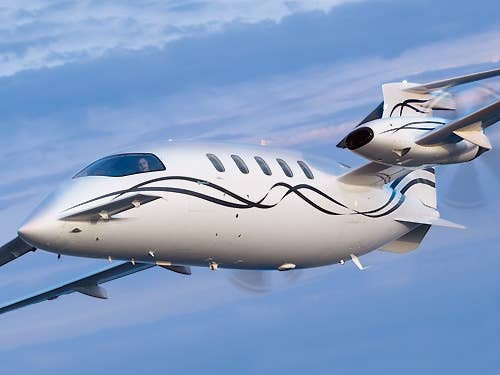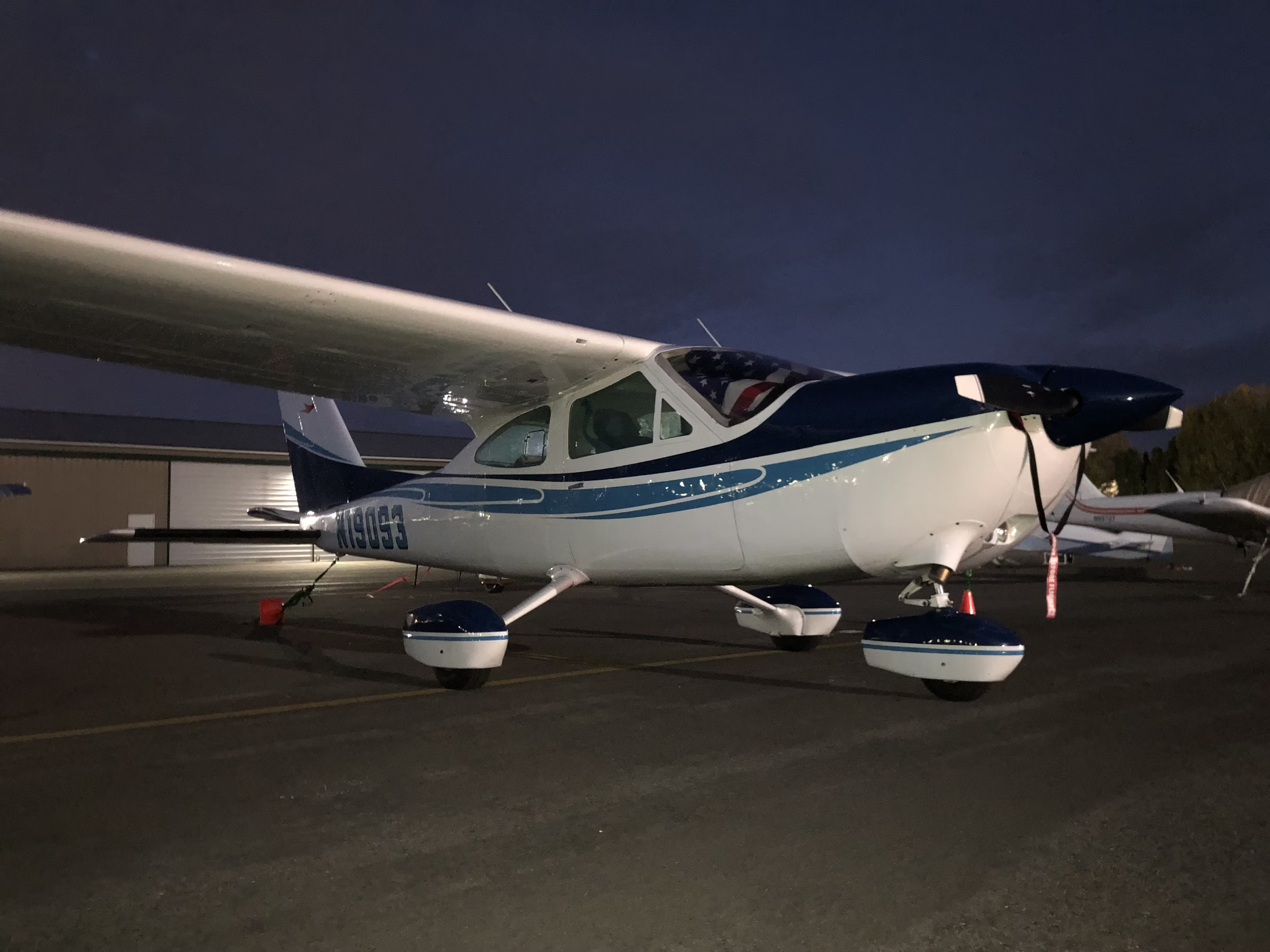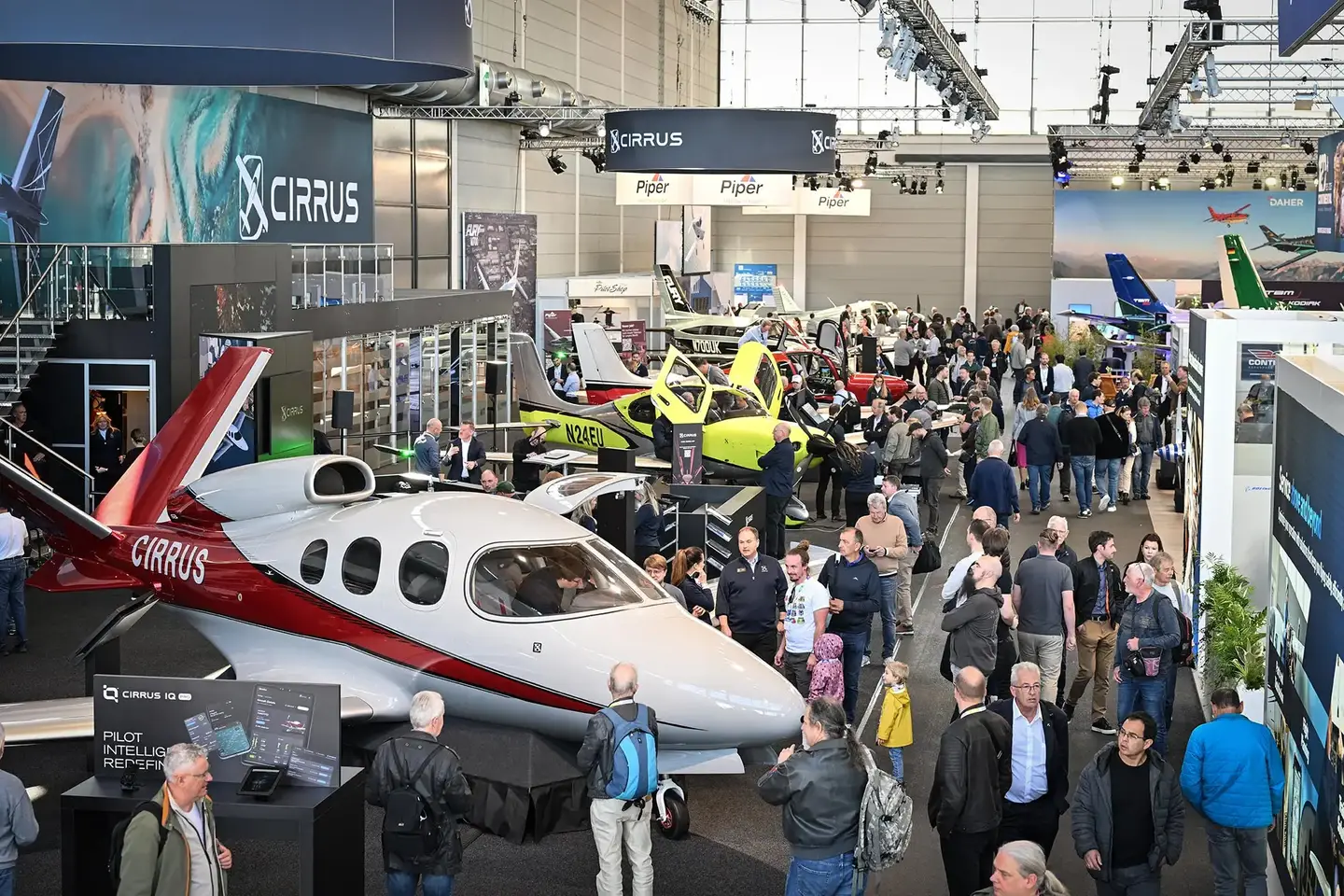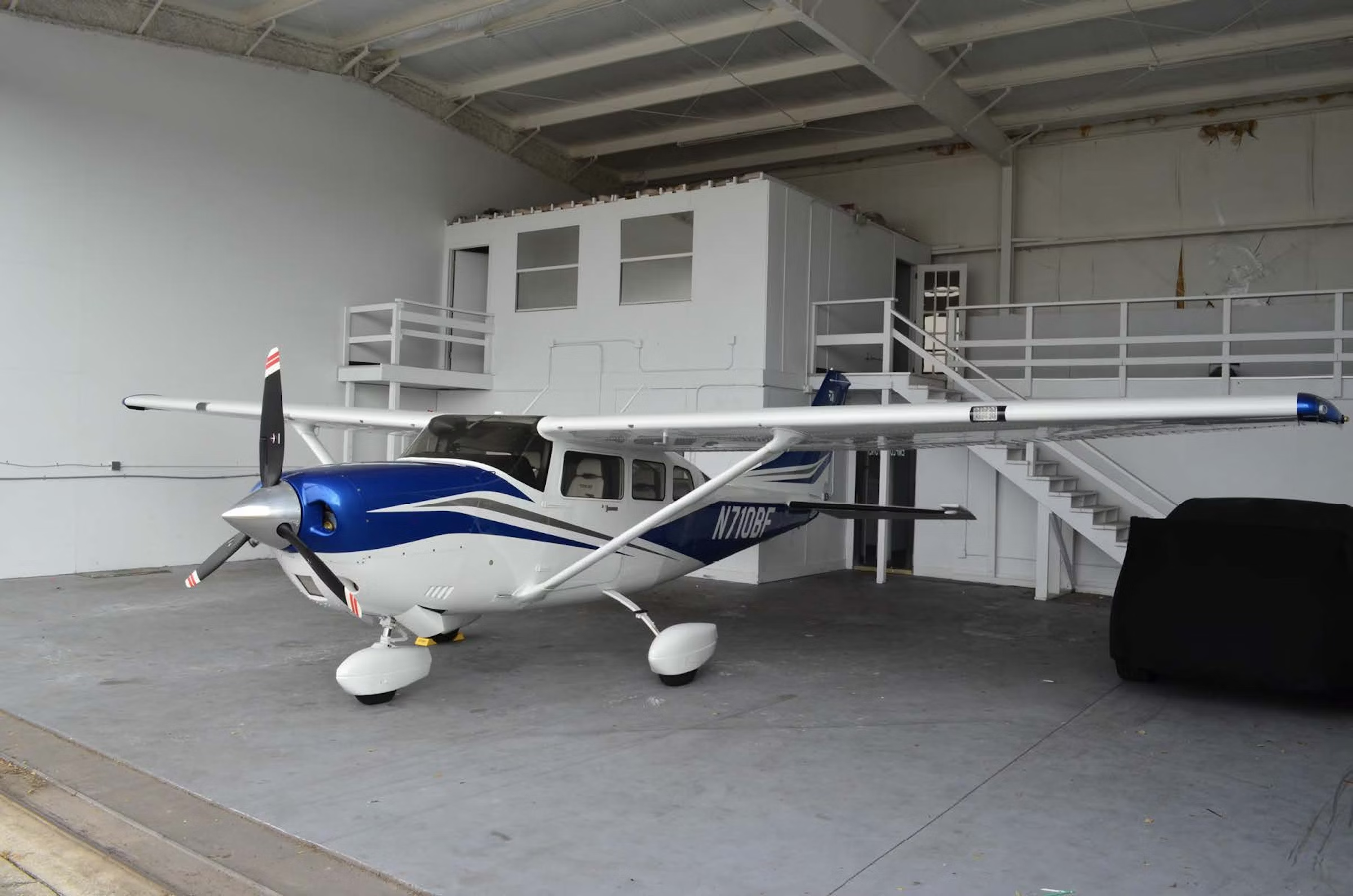
Piaggio P.180 Avanti II
The Piaggio P.180 Avanti II is one of the most unusual, even exotic, looking airplanes in production today. When you look at the airplane and wonder "why did they do that," the answer is always the same -- to fly the biggest cabin the fastest for the least fuel. Efficiency drove every decision Piaggio engineers made when the airplane was created in the late 1980s.
Facing the huge runup in fuel prices of the past year, it is sometimes hard to remember that the worry in the previous oil crisis was of availability more than price. In the 1970s oil experts -- at least the ones who got our attention -- warned that the world was running out of oil at any price, and that the regions that had the oil were so politically unstable that supply disruptions were a certainty. It was in that climate of very little oil left that Piaggio set out to make the best use of the fuel available with the Avanti.
The decision to power the airplane with a turboprop instead of a turbofan jet engine was easy because the turboprop, at least up to cruise speeds in the mid-300-knot range, is more efficient than the jet. Piaggio wanted to match the speed of many of the light and even some midsize jets without the high fuel burn. But after that choice was made, Piaggio set off on a unique design path, with each decision to improve efficiency leading to another unusual feature.
Low drag, and thus fuel efficiency, begins with the wing. In general the longer the wingspan, and the smaller its area, the lower the drag created by the wing as it does its work of generating the lift needed to carry the airplane. A glance at any glider shows how well understood the efficiency of a high aspect ratio -- long and slender -- wing is. Piaggio selected a wing with a span greater than 45 feet, but total area of 172.2 square feet, about the same as a Cessna 172 or other popular light singles.
The Avanti wing is also very thin with an airfoil shape that achieves laminar flow over about 50 percent of the chord. Laminar flow means that air molecules are moving in an orderly and smooth stream, creating the least drag possible. Most wings have only a small amount of laminar flow before the air becomes turbulent and the molecules tumble and jumble in a layer flowing over the wing, and that adds drag. To maintain laminar flow over significant sections of the wing demands a careful airfoil shape, but also a very smooth surface free from ripples and ridges, rivet heads or other fasteners.
In addition to low drag, the other Avanti design requirement was the biggest possible cabin, and a large fuselage creates drag. The Piaggio solution was to design a fuselage of constantly changing cross section that is free from the distinct nose and canopy sections of a conventional fuselage. By blending the windshields into the fuselage as it expands gradually from the pointed nose, the company hoped to achieve some laminar flow over the fuselage as well as the wing. Such flow is difficult to measure, but it appears that airflow remains attached to the fuselage in a laminar flow for at least some distance aft of the nose.
With such a low-drag fuselage shape the benefits would be squandered if it were to sit atop the wing as in a conventional design. The lowest drag way to join a wing and fuselage is to place the wing near the center of the body. That's great for aerodynamic textbooks, or maybe for fighters or Reno racers, but passengers are not going to think highly of a cabin that has a wing spar penetrating the middle. That's why all recently designed jets put the wing entirely under the fuselage and then use large and elaborate fairings to make the air believe the wing is mounted higher and more toward the center of the fuselage.
The Piaggio solution to this problem was to locate the wing aft of the passenger cabin where it could pass through the center of the fuselage without robbing room from people. But this wing location creates its own problems because the tail arm -- the distance from the aerodynamic center of the wing to the horizontal tail -- is short. An airplane pitches around the center of its wing and the horizontal tail balances those pitching forces. When the tail arm is short there is less leverage available to counteract these pitching forces and the size of the horizontal would need to be huge to generate sufficient force.
And that's why the Avanti has a forward wing. Many confuse the Avanti wing with a canard, but a canard is a pitch control surface that replaces the standard horizontal tail. The forward wing in the Avanti only lifts and has a conventional wing flap, but no pitch control capability. The lift contribution of the forward wing lowers the necessary balancing force from the horizontal tail so that it can be smaller and operate with the short tail arm between the tail and wing. In other words, it is the forward wing, or third surface as Piaggio calls it, that allows the main wing to be mounted aft of the cabin where it is most efficient while still having enough pitch control authority from the horizontal tail. The lift contribution of the forward wing also allows the main wing to be as small as it is in area.
The unique configuration of the Avanti also dictates the location of the main landing gear in the aft fuselage where it retracts aft to be fully enclosed by tight- fitting doors. Landing gear and wing loads are concentrated in a single location, which also helps save weight because those loads do not spread to the rest of the airframe. Large ventral fins under the tail act as feathers on an arrow to naturally damp yaw and Dutch roll, and when the airplane is at high angles of attack they produce nose-down pitch force that helps recovery from an impending stall.
Another visible drag fighting measure is the shape of the engine nacelles with their pinched-in "area rule" wasp-waist shape. The Pratt & Whitney PT6 engines are mounted-in the pusher position which gives the propellers a theoretical efficiency edge over a standard tractor arrangement. Keeping the disturbed air of the propeller slipstream behind the wing also helps maintain laminar flow. The pusher location makes sense of the PT6 airflow where air enters the rear of the engine and exits the front. In a normal PT6 installation inlet air must be turned 90 degrees within the nacelle to be pushed into the rear of the engine. In the Avanti nacelle inlet air is fed directly to the engine air intake, though it still must pass over an inertial separator that will spit out any significant bits of ice or FOD before they can reach the engine.
What is not visible from the outside is the construction techniques necessary to achieve the shape the aerodynamics dictate. Many at first assume the Avanti is made from composite materials because the surface is so smooth and the shapes so unusual, but more than 90 percent of the airplane is made from metal with composites used for fairings, nacelles and the horizontal stabilizer.
The wings are made from thick slabs of aluminum that have been machined to create integral stringers and stiffeners in the skins. This is standard in larger jets, but not turboprops. To produce the critical fuselage shape, Piaggio and its initial development partner Learjet pioneered an "outside in" method of construction. Very precise tools were built to hold the fuselage skins in perfect conformity to the design while ribs and stringers were fastened from the inside. All adjustments during the construction process were made on the inside so that the external shape remained true to the design. Other manufacturers now use a version of this process but Piaggio and Learjet were there early.
The Avanti has succeeded in meeting its objectives of speed, large cabin and fuel efficiency, but the airplane is unique in many ways so it is difficult, actually impossible, to generalize. For example, the new Avanti II with its Dash 66B engines can hit 400 knots true airspeed at 31,000 feet, and that puts it into the jet arena of performance. But slowed down to, say, 350 knots at a higher altitude, the fuel efficiency soars as fuel flow drops down to around 600 pounds per hour, or less. The cabin is also difficult to compare because of its constantly changing shape. When measured at its maximum the Avanti cabin is actually a little larger than the Hawker 125 series that has been a perennial midsize jet leader. To say the Avanti is bigger than a Hawker is not accurate, but to say that the cabin is roomy and comfortable is exactly correct. And the Avanti is a turboprop, and like other turboprops weighing 12,500 pounds or less it doesn't meet the engine failure on takeoff requirement of the jets, so runway performance comparisons are not equal.
The Avanti does, however, have a number of features typically found only in jets, including single-point pressure refueling and heated wing leading edges for ice protection. Fuel is carried in the wings and in tanks in the fuselage. Fuel management for the crew requires nothing more than to have enough onboard, or to occasionally transfer fuel from side to side if an imbalance occurs. All of the feeding from various tanks is automatic, as is the fuel distribution to the tanks when the line crew hooks up to the single point refueling port under the right wing root.
The heated leading edges of the main wing are different in that they do not get so hot that paint is blistered. In most jets the leading edges are heated to hundreds of degrees to vaporize moisture on contact, but paint can't endure those temperatures so they have bare polished leading edges. The Avanti's wings are hot enough to prevent ice, but not so hot as to blister the paint. The forward wing has a very thin, almost imperceptible electric heating blanket that keeps it ice free. The engine inlets have pneumatic boots that inflate automatically to remove ice when the ice detection system activates. The vertical and horizontal tails require no ice protection, and the windshields are electrically heated.
The five-blade Hartzell propellers need no ice protection because the hot exhaust is blasted over them continuously. The propellers have delivered excellent performance and reliable service, but their far aft location does make them susceptible to damage from debris kicked up from the runway or taxiway. Piaggio does offer a fender that is mounted just to the rear of the nosewheels that helps prevent stones and debris from being kicked up, but the airplane is still not intended for unimproved runways.
The baggage compartment is located above the wing and aft of the rear fuselage pressure bulkhead and can hold 44 cubic feet of cargo. Soft-sided luggage works best because the compartment curves to conform to the shape of the fuselage. The cabin door is another unusual feature, with a lower half that swings down to form an airstair, while the upper portion of the door has a forward hinge. The door is a combination of the traditional Learjet clamshell and the swinging door of a Citation.
Part of the upgrade to the Avanti II, in addition to the change to Pro Line 21 avionics and the more efficient engines, is a new interior. Large sections of the side panels and overhead are created in single pieces, giving the cabin a very solid and luxurious finish that rivals any midsize jet. There are several cabin options with the core being a club four arrangement in the rear where the cabin cross section is largest. Many select a two-place divan forward along with another single seat. All cabin arrangements have a private and sizable lavatory aft that can also be used as a passenger seat for takeoff and landing. The seats are also new and have the same comfort and adjustment range you would expect in a midsize jet.
The Collins Pro Line 21 system transforms the cockpit of the Avanti II, compared to the original that had early generation EFIS equipment. The three big flat-panel displays of the Pro Line 21 system have all of the capability you expect in a turbine airplane with the MFD in the center showing all engine instruments as well as maps, navigation and satellite weather. A single Collins FMS mounted in the pedestal handles the navigation chores, and a radio management unit in the panel is used to dial in frequencies.
Learjet contributed much to the cockpit design during the original partnership when the airplane was developed in the 1980s and the lineage is evident. There are no overhead switches or gauges, and systems are controlled by toggle switches instead of the now more common push buttons. The pointy nose and swept shape of the fuselage means the cockpit is not as roomy as the maximum size of the cabin would indicate, but it is reasonably comfortable. The windshields that are faired so smoothly into the fuselage provide good visibility, except in the climb where, as in many airplanes, the view forward is blocked at higher deck angles.
Unlike some other PT6 installations the Avanti uses only two levers to control each engine. The throttle controls engine power, and when lifted and pulled aft puts the propellers into reverse. A companion lever provides fuel shut off for engine start and stop, selects idle speed, and controls propeller rpm. With the engines and props behind you and out of sight it's easy to forget that you are in a turboprop and not a jet.
The Avanti has electrically controlled and hydraulically actuated nosewheel steering through the pedals. A button on the control wheel selects either taxi mode with large authority to spin the airplane on the ramp, or takeoff mode with limited authority to control direction at higher speeds. Pilots coming out of other turboprops, or even jets, that have direct mechanical nosewheel steering may find the system sensitive and a little hard to get used to, but I found it to be precise and predictable on taxi. It's all in what you are used to, and any pilot can learn to adjust to the system.
While the Avanti may require less runway than some jets, its runway speeds are high, particularly for a turboprop. The tiny wing has an enormous slotted flap that tracks far aft to add considerable wing area and low speed lift, but it is still a small wing to lift the 12,100 pounds the airplane can weigh for takeoff. At that maximum weight rotation speed is at 120 knots, which is higher than for most newer design jets. With both engines running the Avanti clears a 50-foot obstacle in about 3,300 feet of runway and there is no requirement to consider the effect of an engine failure in the takeoff calculation as you must do in a jet.
Despite its unusual configuration and appearance, the Avanti has totally conventional flying qualities. The airplane is very stable in all axis. As in many jets, but not turboprops, the horizontal tail leading edge moves up and down to provide pitch trim, and it is very powerful and precise. The delta fins under the tail are so effective that there is no need for the yaw damper even at high altitude. The only different flying characteristic of the Avanti is at the stall, where the forward wing quits flying first and as it stalls the nose drops smoothly down no matter what the pilot does with the controls. With the wheel full aft the airplane will bob up and down with the forward wing stalling and recovering on its own.
One other oddity of the Avanti is that when flying in a wet cloud the forward wing loses some of its laminar flow, and if you are hand flying you can feel the nose dip down a little as the forward wing efficiency decreases. It's no big deal and you simply retrim. If the autopilot is flying you'll never notice the change except for maybe a few knots of speed loss. The shape of the leading edges and forward section of both wings is critical to laminar flow performance, and experienced Avanti pilots believe they can see at least a little speed decrease if the leading edges are dirty, bug contaminated, or even if the paint is significantly damaged.
I was aware of the typical turboprop propeller sounds during taxi and takeoff, but once up and climbing that distinct noise seems to recede and the sensation is of being in a turbofan airplane in terms of both noise and vibration. The Avanti climbs quickly with an initial rate of nearly 2,800 fpm at maximum weight. It can be in the low to mid 30s in under 20 minutes, and that is a typical initial cruise level.
We departed weighing 10,900 pounds to see if we could hit the magic 400-knot cruise speed, but air temperature would be the key. The Avanti was climbing at more than 2,000 fpm out of 22,000 feet, but the air temperature was not cooperating with a reading of 12° C above standard. At 31,000 feet, the level for highest maximum speed, the air was still 8° C above, and at maximum cruise with a total fuel flow of 770 pounds per hour, the Avanti gradually accelerated to 383 knots true. Not quite 400, but still impressive for an airplane with such a large cabin and for so little fuel.
Up at 35,000 feet where the air was still above standard temperature we set up a more typical cruise profile of 600 pph fuel to cruise at 367 knots true. The fuel planning rule of thumb is to burn 800 pounds in the first hour for taxi, takeoff and climb, and then 600 pounds in subsequent hours. At lighter weights the Avanti can reach its certified ceiling of 41,000 feet, where fuel flow drops to around 450 pph and cruise speed is about 330 knots. The 9 psi pressure differential keeps the cabin altitude at 6,600 feet at that altitude, and no-wind range can stretch out to about 1,400 nm.
The cockpit of the Avanti is very quiet. I'm sure much of that is due to the propellers being far behind, but also to the shape of the fuselage with its windshields fared into the gradual slope. The cabin is also very quiet in cruise, on par with jets of similar size, and seems to have no more vibration than the jets.
The flaps, which are electrically operated, have a very long 16-second extension time from up to what Piaggio calls the "mid" position, but is normally called takeoff and approach setting. The reason for the slow extension is that the flaps on the main and forward wing move in a sequence that minimizes pitch change. As the main wing flaps extend, the nose wants to pitch down as on most airplanes, so the forward wing flaps follow to counteract that pitch moment. You can detect two distinct "bumps" in the sequence where a little pitch force is transmitted back to the control wheel, but it is very minor and the whole sequence is well timed to create very little pilot workload. The maximum flap extension speed is a rather low 170 knots, and it's typical to extend the landing gear first, which can go down at airspeeds up to 181 knots. The flap extension from "mid" to landing during which all flaps move simultaneously takes only five seconds.
Approach speeds are high with Vref final approach target speed typically at 120 knots. Like most propeller airplanes the Avanti flies final approach nose-down and you need to level the airplane, but not flare, to keep it coming down without the airspeed bleeding off. The propellers can create considerable drag when the power is brought to idle so float above the runway is minimized. The Avanti's carbon brakes are powered by the hydraulic system, but unlike the jets, there is no locked wheel protection on touchdown, and no anti-skid protection on rollout, so it's best to use them sparingly, relying on the effective propeller reverse to slow. Test pilots can get the Avanti down and stopped without reverse in just under 3,300 feet of runway, but anybody with less expertise should consider using runways longer than that.
The Avanti II is approved for takeoff at 12,100 pounds in most countries, including the United States, but is restricted to 11,550 in some jurisdictions. In its standard configuration empty weight can be held down to about 7,800 pounds, though a little over 8,000 is more typical. The airplane I flew, which had a number of options, weighed in at 8,241 pounds empty. But even at that weight there is about 900 pounds of payload, not including the weight of a pilot, when the tanks are filled. That's equal to four to five passengers with baggage and that's not bad for a tanks-full trip.
The Avanti is manufactured in Genoa, Italy, where standard avionics are installed and the airplane is then ferried to Denton, Texas, for interior completion, paint and installation of optional avionics. The order backlog is now over 100 airplanes and the Avantair fractional program that operates only Avantis is going strong. Recently Piaggio has seen a number of flight departments add an Avanti to their fleet to compliment their midsize and larger jets on shorter trips or with fewer passengers. The cabin room in the main club seating area equals the midsize jets, yet a 500 or 600 nm trip takes only about 15 minutes more in the Avanti for about half the fuel.
The original Avanti delivered on the big majority of its fuel efficiency, speed and cabin comfort promises in the early 1990s, but then oil prices plunged and people's focus on efficiency changed and the airplane went out of production after a small run. Now the global focus is back on fuel and the Avanti's timing looks great. The Avanti II is a much more refined airplane than the original, and it compares favorably to any airplane in its price range for fit, finish and quality of materials. A service and support network is in place, and so is top level pilot training from FlightSafety International. But the airplane remains true to its design roots and delivers the most cabin space and cruise speed for each pound of fuel available. And these days, that is a very good thing.

Sign-up for newsletters & special offers!
Get the latest FLYING stories & special offers delivered directly to your inbox






